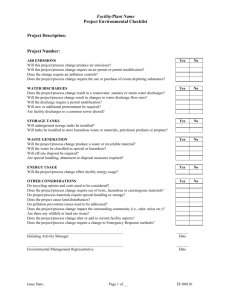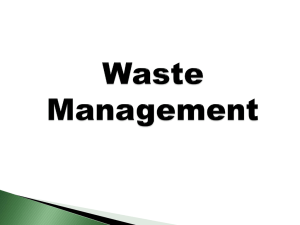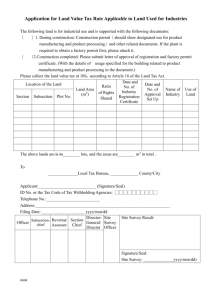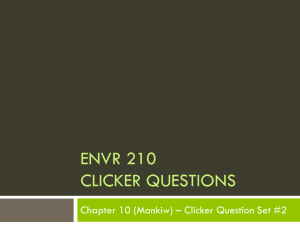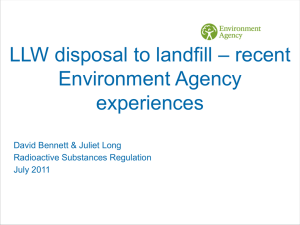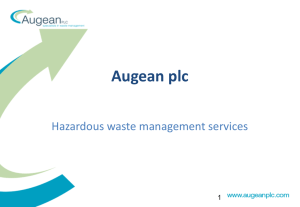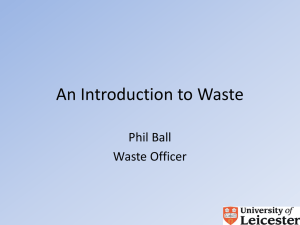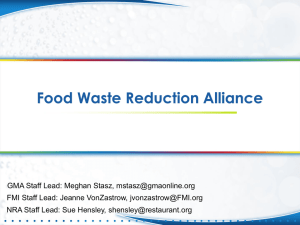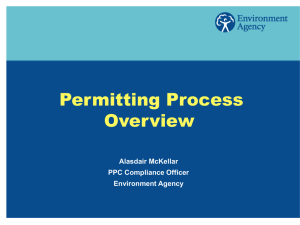Word Document
advertisement
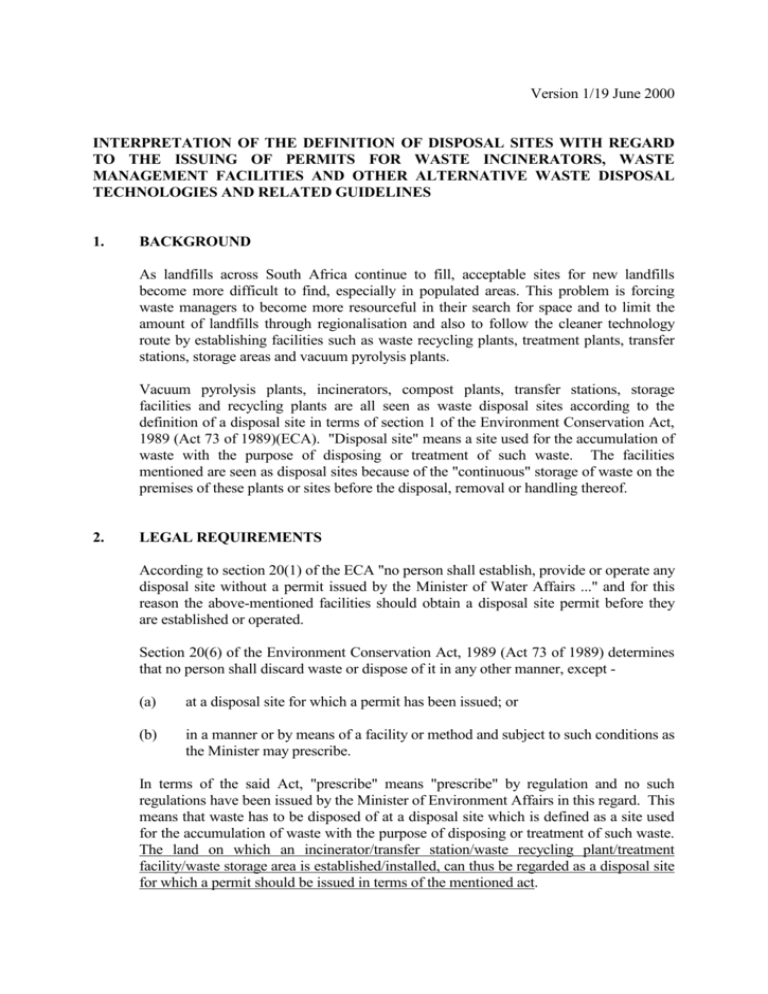
Version 1/19 June 2000 INTERPRETATION OF THE DEFINITION OF DISPOSAL SITES WITH REGARD TO THE ISSUING OF PERMITS FOR WASTE INCINERATORS, WASTE MANAGEMENT FACILITIES AND OTHER ALTERNATIVE WASTE DISPOSAL TECHNOLOGIES AND RELATED GUIDELINES 1. BACKGROUND As landfills across South Africa continue to fill, acceptable sites for new landfills become more difficult to find, especially in populated areas. This problem is forcing waste managers to become more resourceful in their search for space and to limit the amount of landfills through regionalisation and also to follow the cleaner technology route by establishing facilities such as waste recycling plants, treatment plants, transfer stations, storage areas and vacuum pyrolysis plants. Vacuum pyrolysis plants, incinerators, compost plants, transfer stations, storage facilities and recycling plants are all seen as waste disposal sites according to the definition of a disposal site in terms of section 1 of the Environment Conservation Act, 1989 (Act 73 of 1989)(ECA). "Disposal site" means a site used for the accumulation of waste with the purpose of disposing or treatment of such waste. The facilities mentioned are seen as disposal sites because of the "continuous" storage of waste on the premises of these plants or sites before the disposal, removal or handling thereof. 2. LEGAL REQUIREMENTS According to section 20(1) of the ECA "no person shall establish, provide or operate any disposal site without a permit issued by the Minister of Water Affairs ..." and for this reason the above-mentioned facilities should obtain a disposal site permit before they are established or operated. Section 20(6) of the Environment Conservation Act, 1989 (Act 73 of 1989) determines that no person shall discard waste or dispose of it in any other manner, except (a) at a disposal site for which a permit has been issued; or (b) in a manner or by means of a facility or method and subject to such conditions as the Minister may prescribe. In terms of the said Act, "prescribe" means "prescribe" by regulation and no such regulations have been issued by the Minister of Environment Affairs in this regard. This means that waste has to be disposed of at a disposal site which is defined as a site used for the accumulation of waste with the purpose of disposing or treatment of such waste. The land on which an incinerator/transfer station/waste recycling plant/treatment facility/waste storage area is established/installed, can thus be regarded as a disposal site for which a permit should be issued in terms of the mentioned act. 2 There are a few other legal requirements which must be complied with in order to permit and operate a waste disposal site including the above-mentioned facilities eg. the EIA Regulations and the Atmospheric Pollution Prevention Act, 1965 (Act 45 of 1965). EIA Regulations The requirements include compliance to the Environmental Impact Assessment (EIA) Regulations published in April 1998 (promulgated in Government Gazette No. 18261, 5 September 1997). These regulations entail that a scoping exercise be undertaken which must include public participation. Alternative sites must be considered and the best site be identified. The Scoping exercise lead to the submission of a preliminary Environmental Impact Assessment Report to the Department of Environment in the different Provinces (Provincial Government). These Departments will then give guidance regarding the need for a full EIA as part of the permitting process of these facilities. To issue a permit, this Department thus requires a Record of Decision (RoD) or a letter confirming that an exception from an EIA has been given, from the provincial Department of Environment. Atmospheric Pollution Prevention Act, 1965 In the case of incinerators air emissions are one of the issues which must be controlled. Most incinerators in South Africa are currently regulated by local authorities in terms of the Atmospheric Pollution Prevention Act, 1965 (Act 45 of 1965) and the Health Act, 1977 (Act 63 of 1977). The operation of the site and the emissions from the incinerator should be regularly inspected by air pollution staff of these authorities. Conditions are also prescribed for the collection, transportation and storage prior to incineration in terms of the Health Act, 1977 (Act 63 of 1977). Incineration of waste (including medical and hazardous waste) is listed as a scheduled process in terms of the Atmospheric Pollution Prevention Act, 1965 (Act 45 of 1965). Scheduled processes are controlled by the Chief Air Pollution Control Officer of the Department of Environmental Affairs and Tourism (DEAT). The listing as a scheduled process will enable the Chief Officer to issue a registration certificate for a specific incinerator on certain conditions. In terms of section 12 of the Atmospheric Pollution Prevention Act, 1965 (Act 45 of 1965) the registration certificate shall be subject to the condition that all plant apparatus used for the purpose of carrying out the scheduled process in question and all appliances for preventing or reducing to a minimum the escape into the atmosphere of noxious or offensive gases, shall at all times be properly maintained and operated and the holder of the certificate shall ensure that all the necessary measures are taken to prevent the escape into the atmosphere of noxious or offensive gases. The Act also states that due allowance should be made for the unavoidable escape into the atmosphere of noxious or offensive gases during the starting-up of any plant or apparatus in respect of which the registration certificate has been issued or during the period of any breakdown or shut-down or disturbance of such apparatus or plant. The Chief Officer may by written notice require from the holder of such certificate that steps to ensure more effective operation of the appliances be taken. 3 If the permit holder fails to comply with these conditions or requirements within a reasonable time, the Chief Officer may cancel the permit. The following information is specified in the certificate, in terms of section 11(2) of the mentioned Act: (a) the situation and extent of the proposed building or plant to which the certificate relates; (b) the nature of the scheduled process intended to be carried out; (c) the raw materials intended to be used, the nature of the operations intended to be carried out and the products intended to be produced; (d) the appliances intended to be installed and any other measures intended to be taken with a view to preventing or reducing to a minimum the escape into the atmosphere of any noxious or offensive gases likely to be produced by the operations intended to be carried out; and (e) the proposed measures for the purification of the effluents discharged from the appliances installed for preventing or reducing to a minimum the escape into the atmosphere of any noxious or offensive gases for the processes that will be in operation, and for the prevention of the release of noxious or offensive constituents from such effluents when they come into contact with other effluents in drains or drainage canals. It is clear that the certificate mainly addresses the pollution of air by the incinerator, although the pollution by effluents generated at the plant is also regulated. The incineration of waste can however have an impact on every aspect of the environment air, soil, surface and ground water, thereby possibly endangering environmental health. It can just be mentioned that medical waste and the residue after the incineration process is regarded as hazardous waste in terms of the Basel Convention. 3. PROCESS The same process as outlined in Figure 1 (page 1-9) of the document "Minimum Requirements for Waste Disposal by Landfill, second edition, 1998" should be applied with the development and permitting of these facilities. Sites must first be classified according to the type and volume (volume = maximum amount of waste handled/treated/stored per day for which the facility was designed) of waste handled/treated/stored at the specific facility per day . After different locations for the proposed facility have been identified and ranked, a feasibility study on the best alternative site should conducted. After the confirmation of feasibility has been obtained from the Department of Water Affairs and Forestry (DWAF), the applicant applies for a permit. The required documents (according to the Minimum Requirements for Permitting - see Table 5 of the document "Minimum Requirements for Waste 4 Disposal by Landfill) for that specific class site must then be submitted together with the permit application form. Since the Minimum Requirements are written specifically for waste disposal by landfill the level of detail required for each report/investigation could certainly vary for these waste facilities. In the case of general disposal sites the requirements must be discussed and confirmed with the specific Regional Director of DWAF, but a Design Report, Operation Report, Monitoring Report and Contingency Plans would always be required. In some instances, additional studies (eg. Geohydrological Report) could be necessary. 4. GUIDELINES TO COMPILE A PERMIT APPLICATION REPORT FOR THE ABOVEMENTIONED WASTE MANAGEMENT FACILITIES The Permit Application Report should include the information as required above. Guidelines on the type of information which should be given in this report for DWAF to make a decision whether to grant a permit or not is as follows: Background information This section must summarise the following aspects: A. B. C. D. waste classification and quantities current waste management system climatic conditions description of the proposed facility and environmental overview of conditions at the site A. Waste classification and quantities The types of waste generated and to be disposed of/treated/stored at the facility should be addressed e.g. whether it is household refuse for the site to be classified as a G site or whether it is hazardous waste for the site to be classified as a H site and the maximum quantities of waste stored/treated/disposed/handled at the facility per day. This will indicate the classification of the site. B. Current waste management system This section should address the operational area and the population statistics of the area. It should also address waste collection, transport and existing methods of waste disposal/handling/treatment/storage. C. Climatic conditions Climatic conditions of the area, rainfall conditions (mean annual precipitation and evaporation rates), prevailing wind directions should be addressed in this section. It could be that these waste management facilities in terms of the Landfill Classification 5 System indicate that the region is in a water surplus area. A landfill in such an area would be expected to produce leachate and would be designated "B+". However, due to the enclosed designs of most of these facilities climatic factors are expected to have little influence on the waste deposited/treated at the facility. Any leachate that may be generated would be the result of the moisture content of the incoming waste. These facilities will thus be classified as "B-" sites in most cases. D. Description of the proposed waste management facility and environmental overview A description of the site location which includes a topocadastral map (1:50 000) indicating the location of the following, where present, within a 5 km radius of the site boundary: * * * * * * * * the waste management facility the area served existing residential and industrial areas possible future development transport route other waste management facilities in the area zoning and land use of the waste management facility and surrounding area within a 5 km radius, and the 1:50 year floodline of all watercourses. As mentioned earlier in the document a preliminary environmental overview should be undertaken during the Scoping process which inter alia addresses the surrounding land uses, the geohydrology in the vicinity of the site, the ecology and conservation worthiness. The land use upon which these waste management facilities are to be developed should be approved and correctly zoned in terms of local and provincial legislation. Most probably no detailed geohydrological investigation/report will be required as part of the permit application for the above-mentioned waste management facilities. Detailed reports of the following will be required and should be attached to the permit application: * * * * Design report, Operation and Monitoring report Contingency plans Environmental Impact Control Report (only if an EIA is required - consult with DWAF departmental officer and Department of Environment, Provincial Government). Design report This report should address: * infrastructure requirements, * stormwater and leachate management requirements, and 6 * odour control. Operation Plan An overview of the proposed operation of the waste management facility should be given. The following aspects should be addressed: * * * * * * * Equipment description and Maintenance Staffing requirements Screening and acceptance of waste Waste handling, loading, compaction operation Waste Auditing and Reporting Procedures Traffic Control Environmental Control Transportation and final disposal operations should be included in the above plan. In addition to the above, the Operation Plan should also address the following aspects: * * Safety and Emergency Response Fire Prevention A description of the facility e.g. existing infrastructure, ablution facilities, a dedicated telephone etc. should also be addressed. The Operation Plan should also address access control to the site. The general management of these waste management facilities will ensure the control of nuisances. Special measures to ensure good management must be addressed in the Operation Plan. Such measures may include: * * * No unauthorised discharging of waste at the facility No waste picking Roadways and other surfaces must be cleaned immediately after discharge where necessary etc. Monitoring Plan A Monitoring plan should be drawn up and implemented to ensure that the site conforms to permit requirements. Critical aspects to be monitored are: * Types of incoming waste * Excessive leachate production, and * Cleanliness and odours In addition the equipment must be monitored during use to ensure it is in good running order. 7 Environmental Impact Control Report Should an EIA be required and/or if potential environmental impacts be identified during the Environmental Scoping process an Environmental Impact Control Report should be compiled which must address these impacts. In many cases, the impacts identified at these facilities are ground and surface water pollution, odour and visual impacts. These impacts must be addressed in the design and management of the site. Environmental Consequences of failure assessment and report Pollutants can escape into the surrounding environment via surface water, groundwater and/or air/wind flow. Measures to prevent floodwater from entering the facility should be addressed. Storage areas should be built above minimum allowable floor level. In the case of groundwater pollution, measures should be in place to prevent leachate and contaminated stormwater from entering the surrounding environment. Drainage systems should be described in detail. If leachate and contaminated stormwater is pumped to municipal sewers, the approval letter from the municipality should be submitted together with the permit application. Good management of waste management facilities does not require odour control. The situation should however be monitored and if problems arise due to odours the permit holder should respond immediately in an appropriate manner. Methods are aerosol deodorisers, biological filtration and chemical scrubbing. A Response Action Plan should also be submitted if stoppage in the operation of the specific waste management facility will have an environmental impact. 5. CONCLUSION This document only gives broad guidelines with regard to the permit application process applying to disposal facilities. Ad hoc exceptions to these broad guidelines may apply. Of importance is that the legal principles mentioned here and the objectives of the Minimum Requirements must however always apply. It is important to note that the Department does not approve technologies, but issue permits for the use of such technologies in which performance criteria are set. Incinerators must for example be licensed by the Department of Environmental Affairs and Tourism first before a permit for such a "disposal site" will be considered by the Department. Permits which will be issued for these facilities could be an abbreviated or amended version of the standard disposal site permit and conditions which are applicable to the specific facility will be included.
